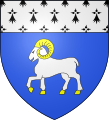Sheep (heraldic animal)

The sheep as heraldic animal is represented in heraldry in two forms. In the description of the coat of arms or blazon it is often described as a lamb or when horns are depicted as a ram ( buck , male sheep). The coat of arms of the Faroe Islands shows the ram, as the archipelago was originally called the Sheep Islands . At least the country is dominated by sheep as domestic animals.
As Agnus dei the sheep is as common figure is a halo or aura placed around the head. It becomes a heraldic animal with a religious message. With its head turned to the left and one foreleg holding a flag, it is depicted as a lamb of God in a coat of arms.
The other representation is a very simple one. Standing or running to the right (heraldic) and also looking, sometimes holding a flag, but without a nimbus, it is a simple heraldic figure. The right front leg is raised. The main color is silver (white) or gold. In this form, it should symbolize sheep breeding and husbandry in the region. Three sheep presented as a three-pass are often shown two over one (2: 1) in the coat of arms. The reinforcement can be tinged differently, i.e. other colors are possible for the hooves and horns. The animals are also shown as sign holders .
Often there are only horns in the coat of arms. These are also often repeated in the upper coat of arms .
Coat of arms of Szeged with a sheep in the upper coat of arms
Sheep in the coat of arms of Dravograd (Unterdrauburg) in Slovenia
Lamb , talking , in the arms of Lamspringe
Aries in the coat of arms of Quimper
With billy goats , chamois , ibex and other horns, it is possible for animals and especially for horns to be confused in heraldry. The description of the coat of arms must clarify it.
The representations of a lamb hanging on an order chain or just the lambskin on it are the symbol of the Order of the Golden Fleece . This medal is placed around the shield with the corresponding full coat of arms .





